Focusing X-Rays
July 20, 2015
There are quite a few
television shows and
movies featuring "
ghosts."[1] Among the supposed abilities of these
incorporeal beings are the ability to walk through objects and have objects pass through them. There are some major inconsistencies in the nature of such ghosts, since they can handle objects, and they don't fall though
floors. There are
second-order inconsistencies, like their ability to
speak, which requires manipulation of
air.
X-Rays have a commonality with ghosts, since they can pass through objects. Their passage is not entirely unimpeded, since there's aways some
attenuation. The
transmittance of X-rays through a
material follows the law,

in which
I/I0 is the
ratio of
intensity to initial intensity,
μ/ρ is the
mass attenuation coefficient of the specific material at the specific X-ray
energy, and ℓ is the distance through the material. There are tables of
μ/ρ for many materials at various X-ray energies.[2]
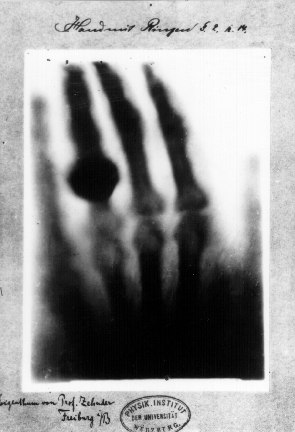
Hand mit Ringen
(Hand with Rings)
X-ray radiograph by Wilhelm Röntgen of the left hand of his wife, Anna Bertha Ludwig, December 22, 1895.
In this first medical X-ray radiograph, it can be seen that the mass attenuation coefficient of bone is much greater than that of flesh.
(Via Wikimedia Commons.)
Although X-rays will zoom through materials, there are special cases when
reflection of X-rays will occur. X-rays will reflect from perfect
crystals when the
wavelength of the X-rays and the spacing of crystal planes meet the
Bragg condition:

in which
λ is the X-ray wavelength,
d is the spacing between crystal planes,
θ is the
incident angle of the X-rays, and
n is the
order of the reflection. The condition,
n = 1, is the equivalent of a
mirror reflection (see figure).
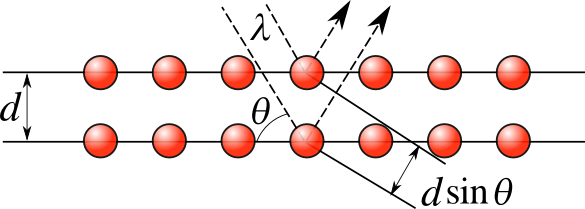
Bragg reflection from a crystal plane. (Illustration by the author using Inkscape.)
While crystal reflection is a way to produce an X-ray mirror, the mirror reflection occurs only at the specific combination of wavelength and
atomic spacing. You can't use Bragg reflection from a
planar crystal to make
X-ray optics, such as the equivalent of a
telescope mirror, even at a specific wavelength, since the incident angle changes. One exotic method to get around this limitation is by
bending a crystal; but, as you can imagine, most crystals would rather shatter than
bend.
One method of forming an X-ray telescope is a
coded-aperture mask. The mask, as its name implies, doesn't
focus X-rays, it blocks them in a way that the
direction of an X-ray can be
calculated from the resulting
pattern on an
imaging detector. The
BeppoSAX X-ray telescope uses a coded aperture mask with a 256 x 256 pattern etched into
stainless steel (see figure).

BeppoSAX coded aperture mask
Each of the 65,536 grid elements is a square millimeter.
(European Southern Observatory image, used with permission of Astronomy and Astrophysics.)
Zone plates will focus X-rays, just as they are able to focus
visible light. A zone plate uses the
interference of waves to focus X-rays, but there's a way to actually focus X-rays by reflection. If X-rays impinge on a
metal surface, they will obey
Snell's law, so there's an
angle for which
total internal reflection is obtained.
For X-rays, this
grazing angle is very small, from a few
arc-minutes to about a
degree, depending on wavelength. This principle is used to focus X-rays in a
Wolter telescope. A
microstructured optical array is an X-ray analog of an
optical fiber bundle. Such an array is prepared by cutting channels into
silicon wafers using
MEMS processing techniques. X-rays are guided by reflection from the gently-curved sidewalls of the channels.
In a recent advance in X-ray optics,
scientists from
Argonne National Laboratory (Argonne, Illinois) have demonstrated how rapidly
oscillating micromechanical mirrors can be used to switch highly intense X-rays by setting the incidence angle just under, or just over, the critical angle for total internal reflection.
Nanosecond switching of an X-ray beam was attained at more than a 100-
kHz repetition rate.[3-4] A
schematic of their device is shown in the figure.
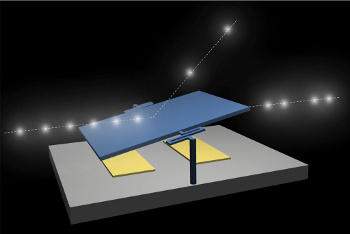
Argonne National Laboratory micromechanical X-ray mirror. The beam is switched at the critical angle for total internal reflection.
(Argonne National Laboratory image courtesy of Daniel Lopez.)
The MEMS reflectors were atomically smooth and flat, a necessary condition for reflecting X-ray
photons of tenth
nanometer wavelength at grazing angles. The reflecting device was fabricated on a
(100)-face silicon wafer, and the mirror was 10
μm thick and 500 μm by 500 μm in dimension. The support was a a pair of
torsional flexures anchored to the wafer (see photo).[3]
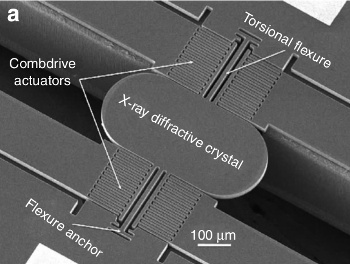
Scanning electron micrograph of the Argonne micromechanical X-ray mirror.
(Fig. 2a of ref. 3, licensed under a Creative Commons license.)[3)]
The speed of the device came from its oscillation, which is
synchronized with the X-ray
pulses emanating from the test source. It would be possible to fabricate mirrors with
MHz oscillation rate. Says
Argonne emeritus scientist, Gopal Shenoy, "It will herald a new era of dramatically new and improved kinds of X-ray
experiments."[4]
Stephen Streiffer, Associate Laboratory Director for
Photon Sciences and Director of the
Advanced Photon Source, remarks that
"Extremely compact devices such as this promise a revolution in our ability to manipulate photons coming from synchrotron light sources, not only providing an on-off switch enabling ultrahigh time-resolution studies, but ultimately promising new ways to steer, filter, and shape X-ray pulses as well... This is a premier example of the innovation that results from collaboration between nanoscientists and X-ray scientists."[4]
The new
technology, developed by scientists from Argonne's
Center for Nanoscale Materials and the Advanced Photon Source, was funded by the
Office of Science of the
United States Department of Energy.[4]
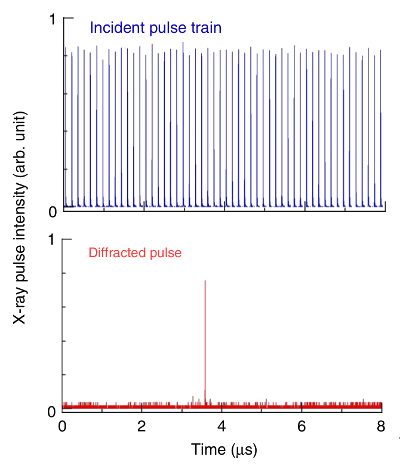
An example of pulse selection by the Argonne X-ray mirror.
One narrow pulse is selected from a pulse train of X-rays.
(Figs. 3b and 3c of ref. 3, reformatted, licensed under a Creative Commons license.)[3)]
![]()
References:
- One modern example is The Haunted Hathaways on Nickelodeon. A classic example is the 1937 film, Topper.
- J. H. Hubbell and S. M. Seltzer, "Tables of X-Ray Mass Attenuation Coefficients and Mass Energy-Absorption Coefficients from 1 keV to 20 MeV for Elements Z = 1 to 92 and 48 Additional Substances of Dosimetric Interest," NISTIR 5632, 1996.
- D. Mukhopadhyay, D. A. Walko, I. W. Jung, C. P. Schwartz, Jin Wang, D. López, and G. K. Shenoy, "X-ray photonic microsystems for the manipulation of synchrotron light," Nature Communications, vol. 6, article no. 7057 (May 5, 2015), doi:10.1038/ncomms8057. This is an open access article with a PDF file available here.
- Scientists tune X-rays with tiny mirrors, Argonne National Laboratory Press Release, May 5, 2015.
Permanent Link to this article
Linked Keywords: Television program; television show; film; movie; ghost; incorporeality; incorporeal being; floor; orders of approximation; second-order; speech; air; X-Ray; attenuation coefficient; transmittance; material; ratio; intensity; mass attenuation coefficient; energy; hand; ring; radiography; radiograph; Wilhelm Röntgen; wife; medicine; medical; mass attenuation coefficient; bone; flesh; Wikimedia Commons; reflection; crystal; wavelength; Bragg's law; Bragg condition; angle of incidence; incident angle; order of the reflection; mirror; Bragg reflection; Miller index; crystal plane; Inkscape; atom; atomic; plane; planar; X-ray optics; reflecting telescope; telescope mirror; bending; bend; coded-aperture mask; focus; Euclidean vector; direction; calculation; calculated; pattern; image sensor; imaging detector; BeppoSAX; stainless steel; European Southern Observatory; Zone plate; visible light; interference of waves; metal; Snell's law; angle; total internal reflection; grazing angle; arc-minute; degree; Wolter telescope; microstructured optical array; optical fiber cable; optical fiber bundle; silicon; wafer; microelectromechanical systems; MEMS; deep reactive-ion etching; processing technique; scientist; Argonne National Laboratory (Argonne, Illinois); oscillation; oscillating; microtechnology; micromechanical; nanosecond; hertz; kHz; frequency; repetition rate; schematic; Daniel Lopez; photon; nanometer; crystal structure planes and directions; (100)-face; micrometer; μm; torsion; torsional; flexure bearing; scanning electron microscope; Scanning electron micrograph;Creative Commons license; synchronization; synchronize; pulse; MHz; Argonne emeritus scientist, Gopal Shenoy; experiment; Stephen Streiffer; Photon Sciences; Advanced Photon Source; synchrotron light source; innovation; collaboration; nanotechnology; nanoscientist; technology; Center for Nanoscale Materials; Office of Science; United States Department of Energy; pulse train; The Haunted Hathaways; Nickelodeon; Topper.